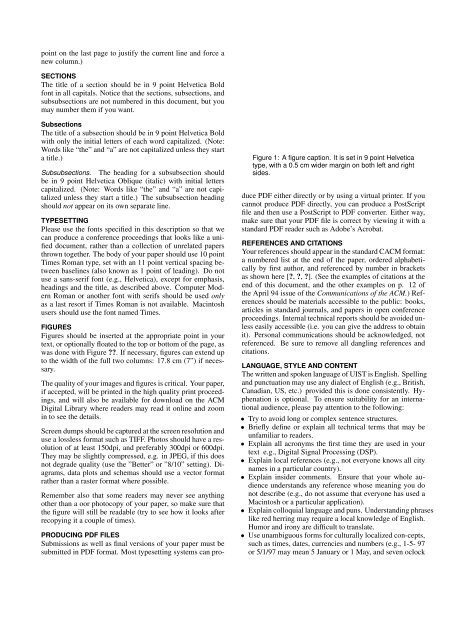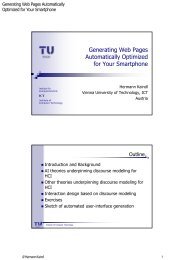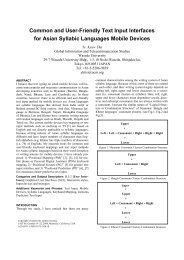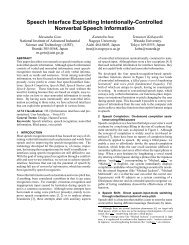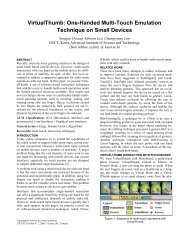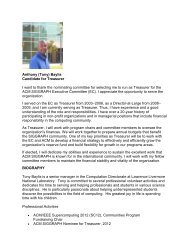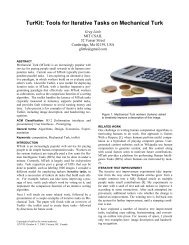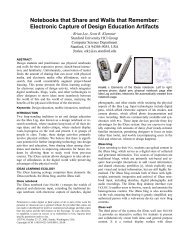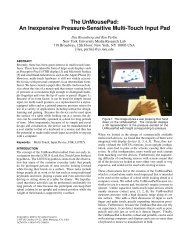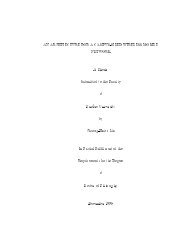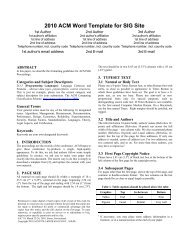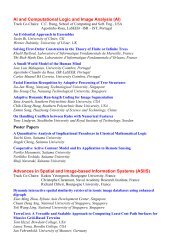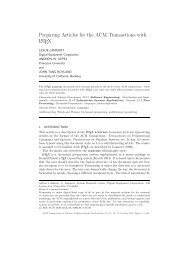Standard UIST Conference Format: Preparing Camera-Ready ...
Standard UIST Conference Format: Preparing Camera-Ready ...
Standard UIST Conference Format: Preparing Camera-Ready ...
Create successful ePaper yourself
Turn your PDF publications into a flip-book with our unique Google optimized e-Paper software.
point on the last page to justify the current line and force a<br />
new column.)<br />
SECTIONS<br />
The title of a section should be in 9 point Helvetica Bold<br />
font in all capitals. Notice that the sections, subsections, and<br />
subsubsections are not numbered in this document, but you<br />
may number them if you want.<br />
Subsections<br />
The title of a subsection should be in 9 point Helvetica Bold<br />
with only the initial letters of each word capitalized. (Note:<br />
Words like “the” and “a” are not capitalized unless they start<br />
a title.)<br />
Subsubsections. The heading for a subsubsection should<br />
be in 9 point Helvetica Oblique (italic) with initial letters<br />
capitalized. (Note: Words like “the” and “a” are not capitalized<br />
unless they start a title.) The subsubsection heading<br />
should not appear on its own separate line.<br />
TYPESETTING<br />
Please use the fonts specified in this description so that we<br />
can produce a conference proceedings that looks like a unified<br />
document, rather than a collection of unrelated papers<br />
thrown together. The body of your paper should use 10 point<br />
Times Roman type, set with an 11 point vertical spacing between<br />
baselines (also known as 1 point of leading). Do not<br />
use a sans-serif font (e.g., Helvetica), except for emphasis,<br />
headings and the title, as described above. Computer Modern<br />
Roman or another font with serifs should be used only<br />
as a last resort if Times Roman is not available. Macintosh<br />
users should use the font named Times.<br />
FIGURES<br />
Figures should be inserted at the appropriate point in your<br />
text, or optionally floated to the top or bottom of the page, as<br />
was done with Figure ??. If necessary, figures can extend up<br />
to the width of the full two columns: 17.8 cm (7”) if necessary.<br />
The quality of your images and figures is critical. Your paper,<br />
if accepted, will be printed in the high quality print proceedings,<br />
and will also be available for download on the ACM<br />
Digital Library where readers may read it online and zoom<br />
in to see the details.<br />
Screen dumps should be captured at the screen resolution and<br />
use a lossless format such as TIFF. Photos should have a resolution<br />
of at least 150dpi, and preferably 300dpi or 600dpi.<br />
They may be slightly compressed, e.g. in JPEG, if this does<br />
not degrade quality (use the ”Better” or ”8/10” setting). Diagrams,<br />
data plots and schemas should use a vector format<br />
rather than a raster format where possible.<br />
Remember also that some readers may never see anything<br />
other than a oor photocopy of your paper, so make sure that<br />
the figure will still be readable (try to see how it looks after<br />
recopying it a couple of times).<br />
PRODUCING PDF FILES<br />
Submissions as well as final versions of your paper must be<br />
submitted in PDF format. Most typesetting systems can pro-<br />
Figure 1: A figure caption. It is set in 9 point Helvetica<br />
type, with a 0.5 cm wider margin on both left and right<br />
sides.<br />
duce PDF either directly or by using a virtual printer. If you<br />
cannot produce PDF directly, you can produce a PostScript<br />
file and then use a PostScript to PDF converter. Either way,<br />
make sure that your PDF file is correct by viewing it with a<br />
standard PDF reader such as Adobe’s Acrobat.<br />
REFERENCES AND CITATIONS<br />
Your references should appear in the standard CACM format:<br />
a numbered list at the end of the paper, ordered alphabetically<br />
by first author, and referenced by number in brackets<br />
as shown here [?, ?, ?]. (See the examples of citations at the<br />
end of this document, and the other examples on p. 12 of<br />
the April 94 issue of the Communications of the ACM.) References<br />
should be materials accessible to the public: books,<br />
articles in standard journals, and papers in open conference<br />
proceedings. Internal technical reports should be avoided unless<br />
easily accessible (i.e. you can give the address to obtain<br />
it). Personal communications should be acknowledged, not<br />
referenced. Be sure to remove all dangling references and<br />
citations.<br />
LANGUAGE, STYLE AND CONTENT<br />
The written and spoken language of <strong>UIST</strong> is English. Spelling<br />
and punctuation may use any dialect of English (e.g., British,<br />
Canadian, US, etc.) provided this is done consistently. Hyphenation<br />
is optional. To ensure suitability for an international<br />
audience, please pay attention to the following:<br />
• Try to avoid long or complex sentence structures.<br />
• Briefly define or explain all technical terms that may be<br />
unfamiliar to readers.<br />
• Explain all acronyms the first time they are used in your<br />
text e.g., Digital Signal Processing (DSP).<br />
• Explain local references (e.g., not everyone knows all city<br />
names in a particular country).<br />
• Explain insider comments. Ensure that your whole audience<br />
understands any reference whose meaning you do<br />
not describe (e.g., do not assume that everyone has used a<br />
Macintosh or a particular application).<br />
• Explain colloquial language and puns. Understanding phrases<br />
like red herring may require a local knowledge of English.<br />
Humor and irony are difficult to translate.<br />
• Use unambiguous forms for culturally localized con-cepts,<br />
such as times, dates, currencies and numbers (e.g., 1-5- 97<br />
or 5/1/97 may mean 5 January or 1 May, and seven oclock


